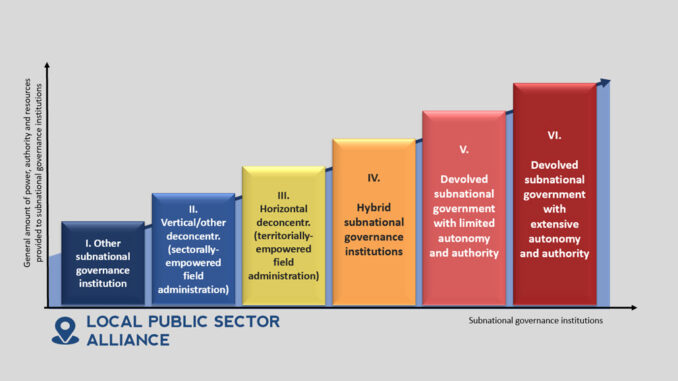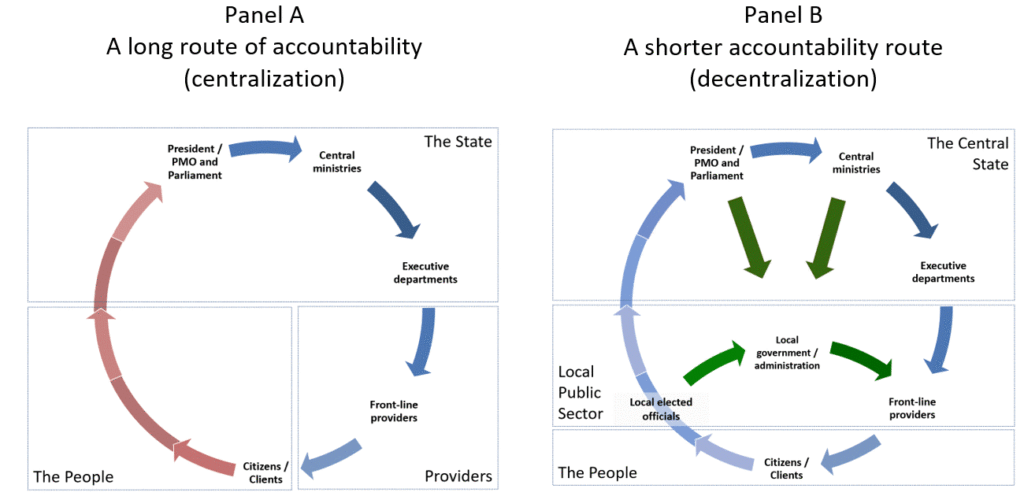
Decentralization (or devolution, to be more precise) is sometimes defined as “the transfer of power, authority, and resources from the central government to local governments”. In other cases, decentralization has been defined as “the empowerment of people through the empowerment of their local governments”.
While these definitions highlight the role that decentralization and local governance institutions can play in achieving inclusive governance, responsive public services, and effective localized development, these definitions are rather incomplete unless we address a closely related question: what, exactly, is a local government?
Unfortunately, the global Community of Practice on decentralization and localization does not have a single consensus definition of local governments. One reason for the lack of a common definition is the multi-disciplinary nature of local governance: since the topic is typically approached by different disciplines—by constitutional lawyers, political scientists, public administration specialists, economists, and others—in isolation, few analyses consider the nature of local governance institutions in a integrative manner. In the absence of an institutional mechanism for bringing together the insights from these diverse disciplines, each discipline seems to have developed some of its own views about what constitutes a local government.
The lack of a clear, consistent global definition is no doubt also due to the fact that the nature of local governance institutions is quite different in different countries, so that many people simply equate the term ‘local governments’ with the type of local governance institutions that prevail in their own country. As a result, the litmus test appears to be that “if it looks like a local government and it quacks like a local government, it must be a local government”. Of course, there are risks involved in studying local governments (or any topic) in the absence of an accurate and consistent definition.
What is a local government, exactly?
The most consistent definition of what constitutes a local government has been prepared by the International Monetary Fund over the years (IMF 1986; 2001; 2014), as part of its efforts to bring together government finance statistics from countries around the world. With some minor adjustments, the IMF guidance gives us a strong foundation for arguing that a local governance institution must adhere to a number of multi-disciplinary criteria in order to be considered a ‘real’ local government, including:
- Legal (corporate) entity: A local government is a corporate body (a legal entity that, in its own name, can own assets, enter into contracts, incur liabilities, sue and be sued, and engage in transactions with other entities).
- Public sector (service delivery) entity: A local government is a mechanism for collective decision-making and service delivery in a local jurisdiction, typically with binding decision-making power (e.g., regulatory and/or taxation powers).
- Political entity: A local government has its own (political/elected) leadership with authoritative decision-making power.
- Administrative entity: A local government has (and controls) its own administration, including its own officers and staff.
- Fiscal entity: A local government owns assets and raises funds in its own name; and prepares, adopts, and manages its own budget.
While these textbooks characteristics of a local government are met in many countries, these characteristics are certainly not met by local governance institutions in all countries around the world—especially when these characteristics are applied in a strict manner. Nonetheless, this list of characteristics–which guides LPSA’s Local Governance Institutions Comparative Assessment framework— provides a useful framework for comparing local governance institutions in different countries.
Why does the definition matter? Linking the characteristics of local governments with local empowerment
The definitional characteristics of a local government noted above are not a subjective list—each of them reflects an important feature required for local governments to function as an inclusive, responsive and accountable part of the public sector.
There is widespread consensus among decentralization experts that, under the right circumstances, devolution can improve the allocative and technical efficiency of the public sector by tailoring policies, taxes, and the provision of public services more closely to the preferences and needs of residents in different regions and localities. More specifically, while it is almost impossible for people to hold the central government accountable for its performance (Figure 1, Panel A), when certain conditions are met, the establishment or increased reliance on democratically elected local governments can enhance the effectiveness of the public sector as a mechanism for inclusive and responsive collective decision-making and service delivery by shortening the “long route of accountability” between the people, public sector decision-makers, and service delivery providers (Panel B).
Although devolution can shorten the accountability route between the people and the public sector, the benefits of devolved governance do not automatically appear simply as a result of transferring powers and resources to the local government level. Instead, there is clear links between the chain of assumptions in the “route of accountability” and the list of textbook characteristics of local governments noted earlier. For instance:
- If the local governance institution is not a corporate body with its own decision-making power, local leaders are unable to respond to their local constituents with respect to service delivery, taxation, or other aspects of local administration.
- If the local political leadership is not elected or does not have authoritative decision-making power, local constituents cannot hold locally elected leaders accountable for their decisions or performance.
- If locally elected leaders lack control over the officers and staff that manage the local administration and deliver local services, local leaders are unable to hold these officers and staff accountable for their performance (and in turn, local constituents would be unable to hold their local leaders accountable).
- If locally elected leaders are unable to prepare, adopt, and implement their own budget decisions, local leaders are unable to direct and implement their own decisions and programs (and thus, again, local constituents would not be able to hold them accountable if their priorities are not addressed).
The important take-away, therefore, is that the definitional characteristics of local government noted above are not just an arbitrary list, or a list based on a specific ideology, but that there is a strong conceptual foundation that links each of the textbook features of local governments to the ability of local governments to engage in inclusive governance, to deliver responsive public services, and to champion localized development.
That said, it is important to recognize that devolution (decentralization of powers and resources to local governments) is not necessarily a superior approach to multilevel governance under all circumstances. For instance, in less-developed contexts, deconcentration may give central government ministries a greater ability to direct resources in a pro-poor manner across the national territory. Yet, when countries pursue decentralization reforms based on the arguments of greater inclusion, responsiveness, accountability, and better public services, then it is important to clearly distinguish between devolved local governments and deconcentrated local institutions.
Part of the challenge with the implementation of devolution, however, is that the success of the reform depends not on the implementation of any single part of the shorter accountability chain, but rather, that its success demands the implementation of each link of the decentralized accountability chain. As such, the success of devolution requires on local governments really being local governments (and meeting all the definitional characteristics of a local government entity).
Are a country’s local governments really local governments?
In determining whether a local government is ‘really’ a local government, it is important that local governance institutions meet the textbook characteristics of a local government not just in form, but also in function. For instance, while many local governance institutions around the world have an elected deliberative body, does this body have real, authoritative decision-making power over key aspects of its organization and functioning?
A central issue is whether local governance institutions “have sufficient discretion in the management of their own affairs to distinguish them as separate from the administrative structure of another government. [Local governance institutions] may be deemed to be dependent agencies of some broader governmental unit where … they lack control over their own officers … [or if] they must submit budget estimates to another governmental entity [for approval] … [or where] important aspects of their administration are controlled by another government entity.” (IMF 1986:14)
Unfortunately, existing analyses of local governance institutions around the world lack the details necessary to distinguish ‘real’ local governments from cases where local institutions have some of the characteristics of local governments in form only, or cases where local institutions do not adhere to all the characteristics associated with fully devolved, autonomous local governments. In fact, just like owl butterflies have evolved with some of the features of an owl (in a case of isomorphic mimicry), an initial review of global practices suggests that local governance institutions in different parts of the world take on the form of local governments, without fully taking on the functions of a local government. For instance:
- Local institutions may have elected deliberative bodies, but these elected bodies may not have authoritative decision-making power over local affairs—for instance, local councils may be given the responsibility to monitor the performance of government officials in their jurisdiction, but may lack the power to direct staff effort or other resources towards the priorities of local constituents over the priorities of the higher-level government (e.g., Cambodia, Timor Leste, Vietnam);
- Local institutions may have elected local bodies by law, but elections may not have happed in a timely fashion in one or more local governments for one reason or another, resulting in a higher-level government appointing officials to act instead of these elected bodies (e.g., provincial and local councils in Sri Lanka, selected cities in India);
- Local institutions may have their own budgets, but these budgets may have to be negotiated with higher-level officials, and then incorporated in the budgets of higher government levels. Alternatively, there may be requirements for the local budget to be approved by the higher government level (e.g., Ethiopia, Uganda);
- Local institutions may officially have own local government officers, but the Chief Administrative Officers (and/or other local officers) may be appointed and controlled (or seconded) by a higher government level (e.g., Bangladesh; India, Nepal, Sri Lanka, Tanzania, Uganda);
- Local institutions may be the formal employer of front-line service delivery staff, but in practice, these staff are employed, seconded, or controlled by a higher government level, making it difficult or impossible for local officials to motivate or terminate underperforming staff (e.g., Nepal, Tanzania, Uganda).
The LoGICA Subnational Institutional Typology
In order to achieve a degree of clarity about the true nature of local governance institutions in different countries, the Local Governance Institution Comparative Assessment (LoGICA) framework includes a Subnational Institutional Typology that allows subnational (regional or local) governance institutions to be classified into one of six different categories, ranging from subnational governments with extensive authoritative decision-making power over a wide range of functions (extensive devolution) to subnational governance institutions that are not legal, administrative or fiscal entities in their own right and/or that lack political, administrative and/or fiscal powers. As a result, this typology is able to distinguish between highly devolved local government institutions—which are typically able to respond to the needs and priorities of local constituents—from local institutions that are less empowered to do so (Figure 2).
Devolved local governments (Types V and VI). Devolved local governments are local governance institutions that adhere to all textbook characteristics of being a local government, in law (de jure) as well in practice (de facto), and in form as well as in function.
Deconcentrated local governance institutions (Types II and III). Deconcentrated local governance institutions are territorially or sectorally subnational field administration units that are empowered administratively as well as budgetarily. An empowered subnational field administration unit is (i) a hierarchically subordinate part of the higher-level government (generally not a corporate body); (ii) does not have authoritative decision-making power (although it may have an elected body with advisory or oversight responsibilities); (iii) a budgetary organization, sub-organization or (sub-)unit of the higher-level government; (iv) may have an executive and/or executive body, typically appointed by the higher-level government, such as an executive committee or a commissioner that executes decisions made by the higher-level government; (v) has officers and public administration staff, which are employees of the higher-level government. As part of the LoGICA framework, other specific conditions need to be met in order for a field administration unit to be considered effectively empowered.
Hybrid local governance institutions (Type IV). Hybrid local governance institutions are institutions that combine features of devolved local governments and deconcentrated local administration units. As such, they are neither fully devolved nor fully deconcentrated institutions. There are numerous different reasons for local governance institutions to be considered hybrid local governance institutions. For instance, a local institution that meets all conditions of a local government but lacks control over its own officers, or a local body that lacks authoritative decision-making power (e.g., its budget needs to be approved by a higher-level government) would be considered hybrid local governance institutions.
Other local governance institutions (Type I). Local governance institutions that fail to meet the conditions of any of the other categories of subnational governance institutions are classified as other local governance institutions. For instance, deconcentrated field administration units that do not have meaningful administrative and budgetary discretion may be classified as ‘other’ local governance institutions.
A more detailed overview of the Subnational Institutional Typology is provided here. Determining the nature of subnational governance institutions requires careful and dispassionate evaluation of the de facto nature of local governance institutions at each level or tier in a country, as it is not unusual for the actual state of multilevel governance to differ considerably from the constitutional of legislative framework defining the multilevel governance system.
Implications for the global policy debates on decentralization
It needs to be reiterated that different approaches to decentralization and localization may be suitable in different countries, and that some countries may prefer to pursue decentralization through a deconcentrated public sector structure rather than through devolution. However, there are clear differences in the way empowerment and accountability operate in a devolved multilevel governance system versus multilevel governance systems that rely on a deconcentrated or hybrid public sector structure.
If a government aims to promote inclusive governance and sustainable, localized development through devolution—in other words, by shortening the route of accountability between the public sector and the people by shifting functional responsibilities, decision-making power and public resources to elected local governments (rather than merely through more effective deconcentration)—it is critically important that the different facets of the multilevel governance system—institutional, political, administrative, fiscal and sectoral—are structured accordingly. Public sector effectiveness and the accountability may be harmed by the lack of consistent implementation of the reforms, for instance, when a locally elected body is put in place, but this locally elected body is not empowered over adequate financial resources, or over its own officers and staff.
Similarly, public sector effectiveness and the effectiveness of development interventions may be hurt by a lack of clarity or consistency. For instance, on one side of the spectrum, when the government is formally pursuing a decentralization policy based on devolution (where functional responsibilities are formally assigned to the local government level), an excessively centralized sectoral intervention is likely to undermine the accountability relationship between local officials and their constituents, thereby violating the principle of ‘do no harm’. On the other side of the spectrum, inefficient development interventions may result when development partners place their trust in local institutions, when in practice, the public sector is more centralized than it appears at first blush and local institutions are de facto only weakly empowered.
Identifying the de facto nature of subnational governance institutions will also help identify the extent to which—and how—subnational governance institutions are contributing to the public sector’s failure to deliver effective localized public services. For instance, if deconcentrated administrative units or hybrid local governance institutions are mistaken for meaningfully devolved local governments, it is easy to place the blame for weak local services or weak local revenue generation on a lack of local political will, when the root cause for the ineffectiveness of local governance institutions may in fact be a lack of accountability and incentives caused in turn by an inadequately designed multilevel governance structure and a lack of local empowerment.
Note: The LoGICA framework follows the IMF’s definition of subnational government institutions, with two general modifications. First, the IMF generally does not deal with the political aspects of local governance (for instance, the IMF does not require local leadership to be elected). In this regard, the LoGICA framework follows the general consensus from the governance and political science literatures about the importance of elected representation. Second, the IMF definition requires that subnational governments—as corporate bodies or institutional entities—should be able to borrow in order to be considered ‘real’ subnational governments. In many countries, there may be good reasons for central governments to prevent subnational governments from borrowing. As such, the LoGICA framework does not consider the statutory (or actual) power to borrow as a precondition for subnational governance entities to be considered fully devolved subnational governments.







